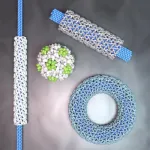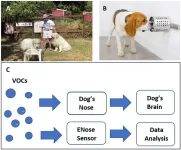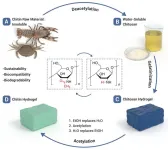(Press-News.org) A new study proposes ways to better incorporate adaptation in climate change research, addressing the uneven distribution of adaptation capacities and needs worldwide.
Research on adaptation to the risks posed by climate change has witnessed significant growth in the past decade, with increasing recognition of its urgency in policy agendas at the international, national, and local levels. Adaptation needs and capacities are not evenly distributed worldwide, with countries in the Global South generally experiencing the highest challenges. Existing climate modeling tools, however, do not account for these differences in adaptive capacities, which may lead to an underestimation of the actual risks.
To help address this challenge, in a new IIASA-led study published in Nature Climate Change, researchers proposed ways to better incorporate adaptive capacity into the framework of the Shared Socioeconomic Pathways (SSPs), a scenario set widely used by climate impact and integrated assessment modeling communities. SSPs describe alternative global development trajectories based on factors such as GDP, demographics, governance, and gender equality, and are able to characterize how well or ill-equipped a society is to cope with climate change.
“There has been previous work pointing at the need to better represent adaptation in climate models,” says Marina Andrijevic, a researcher in the IIASA Energy, Climate, and Environment Program and the lead author of the study. “In this study, for the first time we offer concrete ways to quantify adaptive capacity in climate research. Using the approach we are suggesting, our mainstream modeling tools can incorporate the idea that not all societies will be able to adapt to climate change.”
The researchers provide an overview on how adaptation is represented in conventional modeling tools and show that the SSP scenario framework can be leveraged to assess different categories of adaptation constraints and enablers. The study also offers guidance on model integration for assessing climate change risk and explores future research directions in global assessments used by the Intergovernmental Panel on Climate Change.
“In our modeling efforts, adaptation must be regarded in the broader context of socioeconomic development with a focus on societal empowerment, not only in financial terms, but in the form of education, governance, and gender equality,” says Carl-Friedrich Schleussner, a researcher at Climate Analytics and a coauthor of the study.
The approach detailed in the study can accelerate ongoing efforts to improve the representation of adaptation, account for inequalities, and enable more precise risk estimates and reliable policy advice. To facilitate the integration of adaptive capacity in different research and policy agendas, the researchers also developed a data explorer, visualizing different global futures for indicators that can be used to assess adaptive capacity.
“A better integration of adaptation and adaptive capacity in quantitative risk modeling could show policymakers that we cannot take it for granted that adaptation will simply happen; stringent mitigation must remain the priority for climate risk reduction,” concludes Edward Byers, a researcher in the IIASA Energy, Climate, and Environment Program and a coauthor of the study.
The new framework will also be used in the IIASA-led SPARCCLE project on socioeconomic risks of climate change in Europe, that will start in September 2023. Along with 11 other partners across Europe, including the European Commission’s Joint Research Center, the €6.1 million project will develop new and integrated capacities to assess the risks of climate change and identify synergies between mitigation and adaptation actions.
Reference
Andrijevic, M., Schleussner, C., Cuaresma, J.C., Lissner, T., Muttarak, R., Riahi, K., Theokritoff, E., Thomas, A., van Maanen, N. and Byers, E. (2023). Towards scenario representation of adaptive capacity for global climate change assessments. Nature Climate Change. DOI: 10.1038/s41558-023-01725-1
About IIASA:
The International Institute for Applied Systems Analysis (IIASA) is an international scientific institute that conducts research into the critical issues of global environmental, economic, technological, and social change that we face in the twenty-first century. Our findings provide valuable options to policymakers to shape the future of our changing world. IIASA is independent and funded by prestigious research funding agencies in Africa, the Americas, Asia, and Europe. www.iiasa.ac.at
END
Addressing adaptation inequalities in climate research
2023-07-17
ELSE PRESS RELEASES FROM THIS DATE:
Heading frequency and risk of cognitive impairment in retired male professional soccer players
2023-07-17
About The Study: The findings of this study suggest that repetitive heading during a professional soccer career is associated with an increased risk of cognitive impairment in later life. Further study is needed to establish the upper threshold for heading frequency to mitigate this risk.
Authors: Weiya Zhang, Ph.D., of the University of Nottingham in Nottingham, United Kingdom, is the corresponding author.
To access the embargoed study: Visit our For The Media website at this link https://media.jamanetwork.com/
(doi:10.1001/jamanetworkopen.2023.23822)
Editor’s Note: Please ...
COVID-19 vaccines saved dementia patients' lives in nursing homes
2023-07-17
Deaths among older adults with dementia fell starkly in nursing homes and long-term care centers after COVID-19 vaccinations became available, yet remained high for those living at home, according to a new study led by UC San Francisco.
The nationwide study published July 17, 2023 in JAMA Neurology, is the first to use data from 2019 to 2022 to quantify “excess” deaths – or those above what would have been anticipated had there been no pandemic – taking into account age, sex, racial and ethnic groups, as well as the settings where people died.
In the first year, there were 509,179 dementia-related ...
Reprogramming the shape of virus capsids could advance biomedicine
2023-07-17
Bioengineers have found a way to program the size and shape of virus particles by combining viral protein building blocks and templates made from DNA. The resulting nanostructures could have applications in vaccine development and transporting drugs inside the body.
Virus capsid proteins—the proteins that shield the genome of a virus—can be used to build precisely structured protein assemblies. Their shapes and geometry, however, depend largely on the virus strain. Reprogramming these assemblies, no matter the original ...
World-first clinical trial to help millions with penicillin allergies
2023-07-17
Penicillin allergy affects more than 25 million people in the United States (up to 1 in 10 Americans) and has been shown to lead to particularly poor health outcomes in pregnant women and surgical patients. It is also a public health threat, leading to antibiotic resistance and infections in hospitalized patients that can be life threatening.
Seventy-five% or more penicillin allergy labels come on by age 3 due to, for example, confusion with a viral rash. The majority of these rashes were never allergic, but the labels ‘stick’ into adulthood and carry many adverse consequences.”
Many low-risk patients with a penicillin allergy were able to have their ...
Scent dogs can detect COVID-19 more rapidly and accurately than current tests
2023-07-17
Scent dogs may represent a cheaper, faster and more effective way to detect COVID-19, and could be a key tool in future pandemics, a new review of recent research suggests. The review, published in De Gruyter’s Journal of Osteopathic Medicine, found that scent dogs are as effective, or even more effective, than conventional COVID-19 tests such as RT-PCR.
Dogs possess up to 300 million olfactory cells, compared to just 5 or 6 million in humans, and use one-third of their brains to process scent information, ...
Robotics: New skin-like sensors fit almost everywhere
2023-07-17
“Detecting and sensing our environment is essential for understanding how to interact with it effectively,” says Sonja Groß. An important factor for interactions with objects is their shape. “This determines how we can perform certain tasks,” says the researcher from the Munich Institute of Robotics and Machine Intelligence (MIRMI) at TUM. In addition, physical properties of objects, such as their hardness and flexibility, influence how we can grasp and manipulate them, for example.
Artificial hand: interaction with the robotic system
The ...
Team fabricates chitin hydrogel via chemical transformation of chitosan
2023-07-17
Chitin hydrogel is recognized as a promising material for a variety of biomedical applications. Its biocompatibility and biodegradability make it useful in tissue repair, artificial organs, and wound healing. Yet scientists continue to face challenges in fabricating chitin hydrogel. A team of researchers has developed a green, efficient and scalable preparation method for chitin hydrogels.
The team’s work provides a rational strategy to fabricate chitin hydrogels and paves the way for its practical applications as a superior biomedical material.
Their ...
Report highlights public health impact of serious harms from diagnostic error in US
2023-07-17
Improving diagnosis in health care is a moral, professional and public health imperative, according to the U.S. National Academy of Medicine. However, little is known about the full scope of harms related to medical misdiagnosis — current estimates range widely. Using novel methods, a team from the Johns Hopkins Armstrong Institute Center for Diagnostic Excellence and partners from the Risk Management Foundation of the Harvard Medical Institutions sought to derive what is believed to be the first rigorous national estimate of permanent disability and death from diagnostic error.
The original research article ...
NUTRITION 2023 press materials available now
2023-07-17
Press materials are now available for NUTRITION 2023, the annual flagship meeting of the American Society for Nutrition (ASN). Top nutrition scientists and practitioners from around the world will gather to share the latest research findings on food and nutrition during NUTRITION 2023, held July 22-25 at the Sheraton Boston.
Register for a press pass to attend NUTRITION 2023 in person or to access embargoed press materials before the meeting. Explore the meeting schedule, poster presentations, and oral presentations to see all the exciting research topics covered at this year’s meeting.
EMBARGOED MATERIALS
Researchers Identify Genes ...
Do common methods for protecting bees from pesticides actually work?
2023-07-17
Annapolis, MD; July 17, 2023—Responsible use of pesticides includes striving to avoid negative effects on the environment, often with an emphasis on protecting bees and other pollinators. A new study, however, finds that many common methods for minimizing pesticides' impact on bees—even some recommendations on product labels—are backed by minimal scientific evidence.
The researchers behind the study say stronger testing is needed to evaluate which bee-protection measures are truly effective ...




